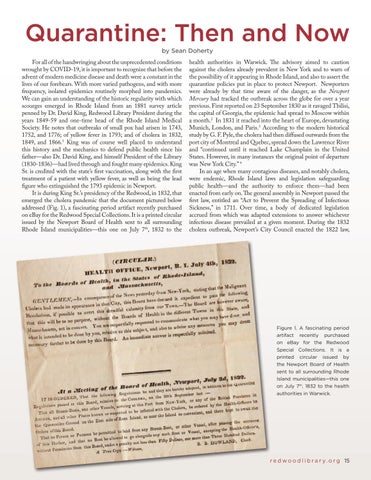Quarantine: Then and Now by Sean Doherty
For all of the handwringing about the unprecedented conditions wrought by COVID-19, it is important to recognize that before the advent of modern medicine disease and death were a constant in the lives of our forebears. With more varied pathogens, and with more frequency, isolated epidemics routinely morphed into pandemics. We can gain an understanding of the historic regularity with which scourges emerged in Rhode Island from an 1881 survey article penned by Dr. David King, Redwood Library President during the years 1849-59 and one-time head of the Rhode Island Medical Society. He notes that outbreaks of small pox had arisen in 1743, 1752, and 1776; of yellow fever in 1793; and of cholera in 1832, 1849, and 1866.1 King was of course well placed to understand this history and the mechanics to defend public health since his father—also Dr. David King, and himself President of the Library (1830-1836)—had lived through and fought many epidemics. King Sr. is credited with the state’s first vaccination, along with the first treatment of a patient with yellow fever, as well as being the lead figure who extinguished the 1793 epidemic in Newport. It is during King Sr.’s presidency of the Redwood, in 1832, that emerged the cholera pandemic that the document pictured below addressed (Fig. 1), a fascinating period artifact recently purchased on eBay for the Redwood Special Collections. It is a printed circular issued by the Newport Board of Health sent to all surrounding Rhode Island municipalities—this one on July 7th, 1832 to the
health authorities in Warwick. The advisory aimed to caution against the cholera already prevalent in New York and to warn of the possibility of it appearing in Rhode Island, and also to assert the quarantine policies put in place to protect Newport. Newporters were already by that time aware of the danger, as the Newport Mercury had tracked the outbreak across the globe for over a year previous. First reported on 23 September 1830 as it ravaged Tbilisi, the capital of Georgia, the epidemic had spread to Moscow within a month.2 In 1831 it reached into the heart of Europe, devastating Munich, London, and Paris.3 According to the modern historical study by G. F. Pyle, the cholera had then diffused outwards from the port city of Montreal and Quebec, spread down the Lawrence River and “continued until it reached Lake Champlain in the United States. However, in many instances the original point of departure was New York City.” 4 In an age when many contagious diseases, and notably cholera, were endemic, Rhode Island laws and legislation safeguarding public health—and the authority to enforce them—had been enacted from early on. The general assembly in Newport passed the first law, entitled an “Act to Prevent the Spreading of Infectious Sickness,” in 1711. Over time, a body of dedicated legislation accrued from which was adapted extensions to answer whichever infectious disease prevailed at a given moment. During the 1832 cholera outbreak, Newport’s City Council enacted the 1822 law,
Figure 1. A fascinating period artifact recently purchased on eBay for the Redwood Special Collections. It is a printed circular issued by the Newport Board of Health sent to all surrounding Rhode Island municipalities—this one on July 7th, 1832 to the health authorities in Warwick.
r e d w o o d l i b r a r y . o r g 15







